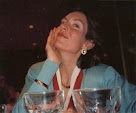The corner showing the market wall and the countryside wall, above the boulangerie
The final wall in my series of murals at PB Boulangerie Bistro, in Wellfleet, MA, is all about the countryside surrounding Lyon and some very important players in the gastronomic life of the city.
It's fair to say that wine is at least as important as food, in this region of France. While Lyon lies between Beaujolais, Burgundy and the Rhône-Alpes (and is technically situated in the Rhône-Alpes region), Beaujolais is the prevalent wine in the area, so I painted vineyards of Gamay grapes, the primary grape used in the production of this wine. Here, workers are picking the grapes to go into the season's vintage.
The gamay grape is deep purple at it's ripest. I painted my grapes a little brighter so they would show up from a distance.
The rooster is one of the most common symbols of France, but it also means good luck for a chef to have a rooster in his restaurant.
The signs point to the two big wine making regions around Lyon.
The signs point to the two big wine making regions around Lyon.
Joseph Rispoli, father of Chef Philippe, along with eleven of his buddies - all of whom are movers and shakers in the world of French food and wine - got together and bought a vineyard in Régnié, which has just begun to produce wine. The vigneron (winemaker) is Patrick Péchard, one of the twelve gourmet pals. The bottle pictured on the barrel is their wine, a Beaujolais-Villages called Cuvée Croix Penet. (I am writing a separate post about this group and their wine - coming soon.)
The goose who has wandered up to Joseph is a foie gras producing goose. Not only is foie gras adored all over France, but it is a staple of Chef Philippe's menu at PB Bistro. I personally can't get enough of his Seared Foie Gras with Tarte Tatin and Candied Nuts, deglazed with Sherry Vinegar. It is sweet, salty, savory, nutty, crunchy, smooth... rich and earthy, piquant and unexpected - every bite a delight for the senses! (I'll have to order it again soon, so I can take a picture to share - how's that for an excuse?!)
The pigs are so important for the vast array of charcuterie that comes from France, especially Lyon. From pâtés to sausages to hams, charcuterie in all its forms can be found on every restaurant and home table. Chef Philippe makes his own charcuterie at PB Bistro.
The best beef in France comes from the cattle raised in and around Charolles, in the Bourgogne region, near Lyon.
A fun video of Charolais cattle being shown off at an annual festival - French pride in their animals is clearly evident!
Dotting the hillsides behind the cows are sheep and goats. Cheeses from this region come from the milk of all three animals. Some cheeses are made with a mixture of two.
Rolling hillsides with charming red-roofed towns dot the landscape. The red roofs originated with the Romans, who created terra cotta here. Almost every town has its own little antique church. Often, unexpected treasures of art, such as murals, can be discovered within their walls.
The Romans occupied this area as long ago as 43BC and Roman ruins are still plentiful in the countryside around Lyon. Here, I have painted the remains of an aqueduct, built by the Romans to carry water from local rivers to the towns, as well as to vineyards and fields for irrigation. And yes, the Gallo-Romans planted vines for wine here, all those centuries ago. Fragments of pottery found in an ancient vineyard near Gevrey-Chambertin date it to the 1st century BC.



















.jpg)











































